Making Mustang Monument
Madeleine Pickens’ efforts to create an eco-sanctuary for American Mustangs and a tourist learning destination are coming to fruition.
by Karen Braschayko
Businesswoman and philanthropist Madeleine Pickens has spent four years fighting hard to create a home for American Mustangs. Her vocal and passionate campaign to educate the public about the plight of wild horses has even her earned the title of “Mustangs’ Messiah.” Finally, her diligence is reaping results, and her eco-sanctuary called Mustang Monument has become a reality.
Mustangs purchased from the Paiute Nation are released at Mustang Monument.
With her husband, business magnate T. Boone Pickens, Madeleine Pickens campaigned against horse slaughter in 2006. Their efforts helped to create the American Horse Slaughter Prevention Act (HR 503), but for Madeleine this was not enough. She formed a foundation called Saving America’s Mustangs and began a frustrating battle with the Bureau of Land Management (BLM) to house federally owned Mustangs in an eco-sanctuary.
Pickens has envisioned thousands of acres for Mustangs to run free, but she also seeks to create a living museum to our Western heritage. Mustang Monument will educate the public about how wild horses have contributed to our history, celebrate Native American culture, and allow visitors to experience the West on preserved land.
I had the honor of speaking with Madeleine Pickens, and she gave me an update on the progress of her sanctuary. She explained her motivations, her struggles and the rich future she sees ahead for all of us at Mustang Monument.
.jpg)
Freed American Mustangs. Photo by Jo Danehy.
A Passion for Saving America’s Mustangs
Pickens’ powerful drive and admirable goals for the Mustangs grew out of a deep love of animals, a thoughtful empathy for her fellow humans, and an enthrallment with the West that began in her childhood.
Born in Iraq to a Lebanese mother and an English father, Pickens fell in love with the American West while watching Westerns with her family as a child. When she immigrated to the United States, she found that the West was much different than she had expected and feared that it was slipping away.
“I’m so keen to save it,” she said. “First of all because I love animals, and I don’t think they should be treated this way. And secondly, I immigrated to this country, and I was fascinated by the West before I ever came. I mean, John Wayne was my hero.”
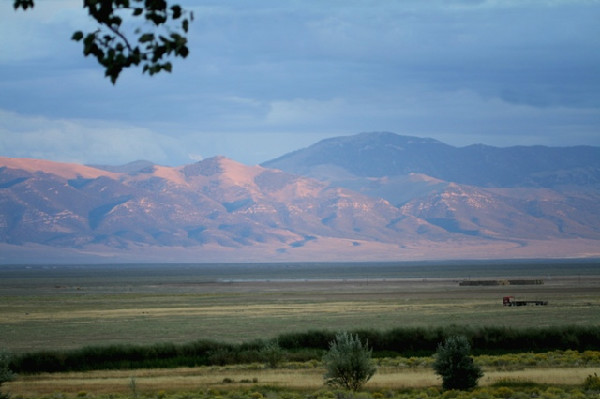
The landscape at Mustang Monument. Photo by Jo Danehy.
Pickens developed an adoration for equines at a young age. A horse lover since childhood, she rode in England and the Middle East before immigrating to the United States. Her daughter inherited the equestrian passion and competed in Grand Prix show jumping in Europe, Canada and the U.S.
Pickens was involved with Thoroughbred racing for many years as an owner of several winning horses, but she had not heard of horse slaughter until seven years ago.
“It was just shocking to me to see that we slaughtered horses,” she said. “For all of the time that I spent in the racing industry, I never knew about horse slaughter. It was terrible when I found out about it. I was so ashamed. I was embarrassed. I was mortified. So naturally, I had to do something about it.”
Pickens’ love for all animals had taken her to New Orleans, Louisiana, after Hurricane Katrina in 2005. While rescuing 800 cats and dogs, she met people who informed her about the fate of many horses — being slaughtered for meat and their body parts.
“Turns out I met lots of advocates,” she said. “What I found out was that we had horse slaughter. The more I got into that, and my husband testified to it in Washington, I learned about the plight of the Mustangs, and I was so ashamed. I thought, ugh, this is horrible, and I honestly would cry. I would look at the video and I would just cry at them being gathered up and taken away and destroyed from their families.”
Pickens knew she needed to do something, and she became acutely motivated to come up with a preservation plan.
“I said a prayer,” she explained. “I said, ‘God, help me come up with a solution for this.’ I woke up in the morning, and it was like the sun came out. Why can I not do what ranchers do? Buy a ranch. Ask the government to convert the grazing allotment on the public lands that I purchased from cows to horses.”
Pickens dove in and learned everything she could. A century ago, there were two million wild horses roaming the West. Now, fewer than 30,000 horses remain free. Over 35,000 wild horses have been rounded up harshly by helicopter and placed into holding pens, where they barely have room to move. Pickens said that federal lands had been set aside specifically for wild horses, but ranchers have gained the right to the federal grazing lands for their cattle. Mustangs are in the way, in their view.
.jpg)
Spruce Ranch. Photo by Jo Danehy.
“One thing that people probably don’t know is that when the law went into effect, the Wild Free-Roaming Horse and Burro Act in 1971, there were over 50 million acres that were set aside for the horses,” she said. “They were called Herd Management Areas, HMAs. And over the years, over 20 million acres were taken away from the horses, but never once did they mitigate and give them another acre of land anywhere else. So you’ve got all the cattlemen screaming there’s too many of them out there, which incidentally is not true, because I have taken the time to fly over millions and millions of acres, and there’s not an abundance of horses out there. There are a lot of myths that are fabricated that people actually start to believe.”
Pickens formed her plan and began to act. The BLM said that her sanctuary would be most feasible in Northern Nevada, and so Pickens purchased two ranches in Elko County. She now owns around 18,000 acres, with a grazing allotment on 550,000 acres of federal land. In addition to giving the wild horses back their freedom, Pickens’ eco-sanctuary will save taxpayers money. Keeping wild horses in holding pens costs taxpayers $1,500 per horse each year, much higher than the $500 she would ask for, which is the standard amount paid to ranchers housing wild horses.
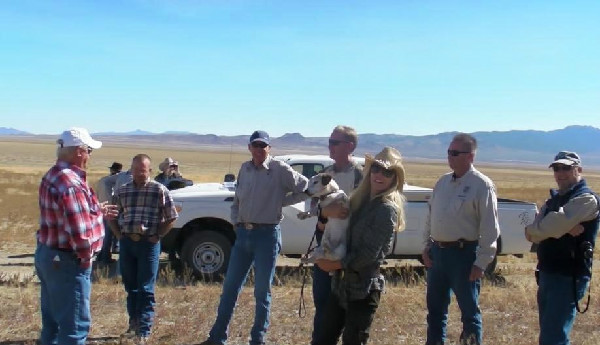
Madeleine Pickens (center, with dog) and members of the Nevada BLM assess the land at Spruce Ranch. Photo by Jo Danehy.
The government agreed to her plans at first, Pickens said, but then they began asking for feasibility studies and environmental studies. Pickens took her grassroots campaign to the internet, television, radio, and every outlet she could, fighting to educate others about the poor lives Mustangs had in holding pens.
Despite some vocal supporters in Congress, the government stalled on allowing Pickens to have any federally owned Mustangs. She worked vigorously for four years and took one step at a time. When she learned that the Paiute Nation was selling about 550 wild horses, she bought them directly from the truck headed to the slaughter house.
“So I’ve been doing this all myself,” she said. “I finally rescued these horses, and I’m not going to wait for the government. I have these horses on my deeded land. These 570 horses are not on public land. They are on my private, deeded land. I bought the Spruce Ranch, and I put that in a foundation, a 501(c)(3), so whether or not the government decides to give me horses, it’s just sitting there waiting for the horses. Even after I die, it’s there, waiting on them.”
Finally, on April 19, 2012, the BLM announced that they had approved Pickens’ eco-sanctuary proposal and that 900 horses would be released to the foundation’s care. Ecstatic and tremendously grateful to her supporters, Pickens plans to be on the first truck carrying the horses to their new home, her sanctuary. She hopes this is the beginning and that many more shipments will come.
Education and the Full West Experience
Pickens envisions Mustang Monument as a sort of national park dedicated to Mustangs. By creating a home for wild horses, she also wants to create a living, breathing monument to our history that will educate visitors on the heritage of the American West. Hands-on experiences will be the ultimate teacher, bringing history lessons from the page and into real life.
Pickens wants people to see, hear, feel and smell the beautiful horses, as well as the breathtaking environment in which they live. Picture camping in a field and waking up with a wild horse herd, or imagine jostling in a covered wagon pulled by Mustangs, just as some emigrants traveled on the Oregon Trail. Visitors will also have the opportunity to ride Mustangs through the desert they know so well.
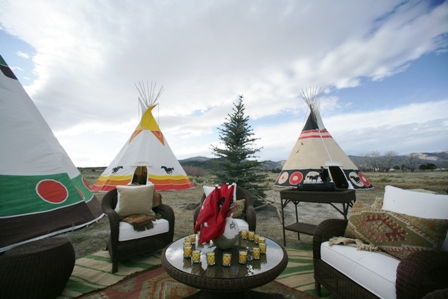
Teepees for camping at Mustang Monument. Photo by Jo Danehy.
“I’ve got a ton of Mustangs that have been really well trained, and they are riding horses,” she said. “They also are performance horses. They will do shows.”
Pickens also plans educational centers for many different subjects. She would like to see programs for photography, art, creative writing, ecology, astronomy, archery, rock climbing, hiking, scouting, survival camps, and Native American culture around the campfire.
Pickens is motivated by a strong desire to educate children, families and anyone who wants to learn about Western heritage. When her daughter was in grade school, Pickens was surprised by how few history book chapters covered Lewis and Clark and the story of the American West.
“The history of our land is so vital. So I’ve really worked hard to change this,” she said. “And when the families come, bring Grandma, bring your aunts, your uncles, your kids, your grandkids — everybody will leave having had an incredible experience.”
Pickens hopes to open Mustang Monument to the public as early as 2013.
“I really think next year,” she said. “I’m very hopeful. This year is more for us to put up our infrastructure. We’re building the infrastructure so we’ll have places for people to stay, where they will enjoy sleeping. We’re purchasing teams of horses so that they can pull carts and take people out.”
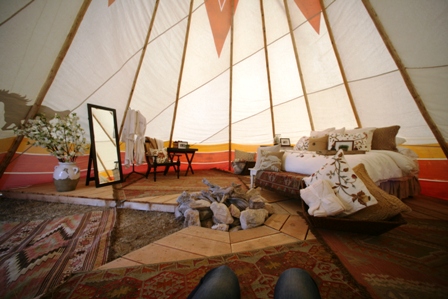
Gourmet camping at Mustang Monument. Photo by Jo Danehy.
Promoting Wellness in Nature
Pickens’ vision for Mustang Monument includes mind-body wellness and environmental awareness. She hopes to aid people in healthy living, help them taste produce right from the land, and offer a healing perspective on the spiritual aspects of life.
She wants people, especially children, to connect with the natural world around them. She sees participating in the process as key. She is creating a greenhouse and a large garden where visitors will be “watching kids grow vegetables on the land,” she said. “In the end, you want to have a wellness center, so people can come and eat right, and do yoga, and see the horses. Teach them about our heritage, and teach them about how the wild horses lived.”
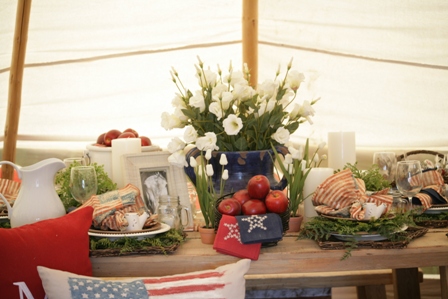
Pickens plans to grow produce at Mustang Monument. Photo by Jo Danehy.
When Pickens talks about the horses she has already gathered at Mustang Monument, you can hear the love in her voice. She enjoys watching them feed in the evenings and wants to share this moving experience with others.
“It is very sweet to see the way the horses all come,” she said. “It’s like having 600 dogs, except the dogs will go crazy barking and carrying on, and the horses don’t. They do watch for us coming. They look for us, and they all come to the fence waiting. It’s cute. But they’re civilized. It’s not a mad rush.”
Pickens wants to make sure that people see the lessons of family and social connection that they can take from observing wild horses.
“They have very strong family ties,” she said. “That’s why when we gathered them and rushed them out and captured them, taking them away was awful. Some went to slaughter, and all the families would be separated. The colts would be separated from the mares, and the babies taken away from the moms. They really destroyed the family that they had. I want people to learn about that. Why does man try and destroy things rather than try to make things better?”
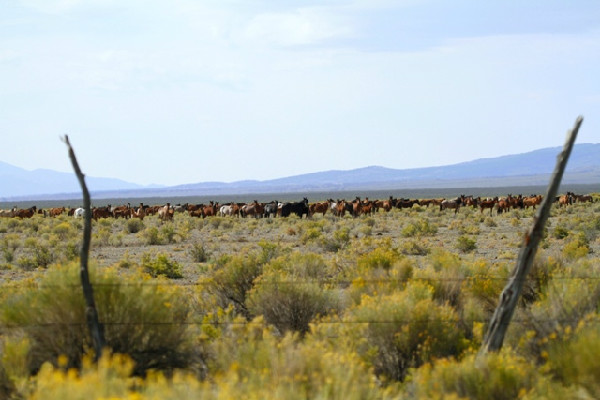
American Mustangs on the range. Photo by Jo Danehy.
Pickens plans to include veterans in her wellness efforts.
“Oh that is a big joy that I would have. Like anything else, whatever you do, you want to include something to take care of wounded warriors,” she said. “So we would want to at some point have a patriotic village where we can work with them and invite them to come and spend a week and also enjoy the West.”
She is profoundly touched by the sacrifices of military service and wants to help in whatever ways she can.
“It’s phenomenal,” she said. “They just truly gave and gave, and they gave their arms and legs and their mothers and their fathers and their sisters and brothers and husbands, and we’ve never really thanked them for it.”
How to Help the Mustangs
Pickens will need support from horse lovers and the public to continue her work for the Mustangs. She suggested signing up for action alert e-mails at SavingAmericasMustangs.org.
“We always put out the word and ask people to respond when we need something done, such as either call your senator or let the BLM know,” she said. “Facebooking, spreading the word, is key. The one thing that has made my project move, apart from my persistence, is the huge number of people on our website.”
Dr. Karen Bale has written a children’s book in support of Pickens’ vision. The Preschool Professors Meet Madeleine and the Mustangs is a colorful, hopeful vision of what visits to Mustang Monument will provide — experiences in nature, respect for the land around us, reminders of our history, and appreciation for majestic American Mustangs in their wild habitat.
Learn more at SavingAmericasMustangs.org.
Karen Braschayko is a freelance writer and horse lover who lives in Michigan, and she would like to thank C.L. for this idea.




